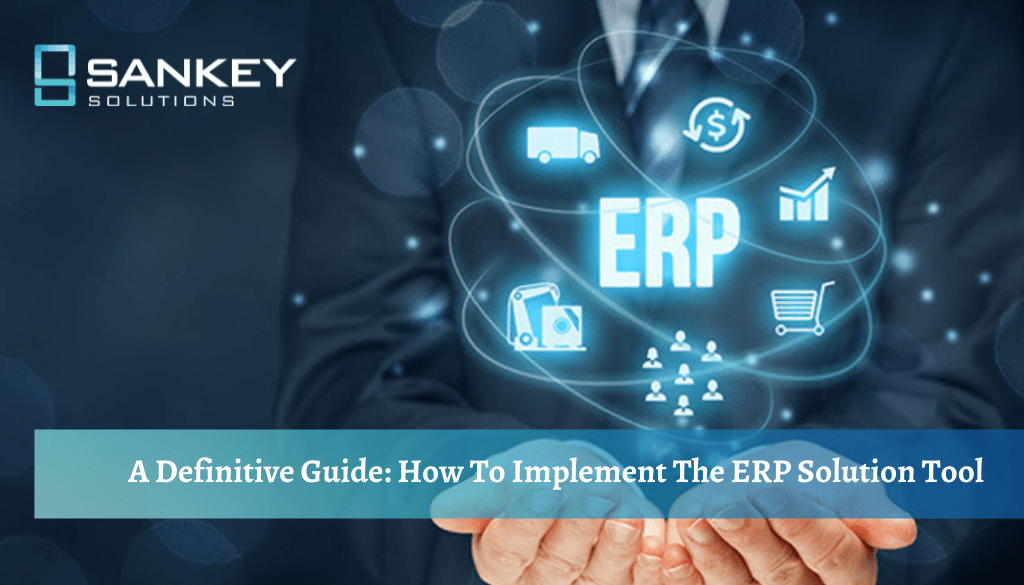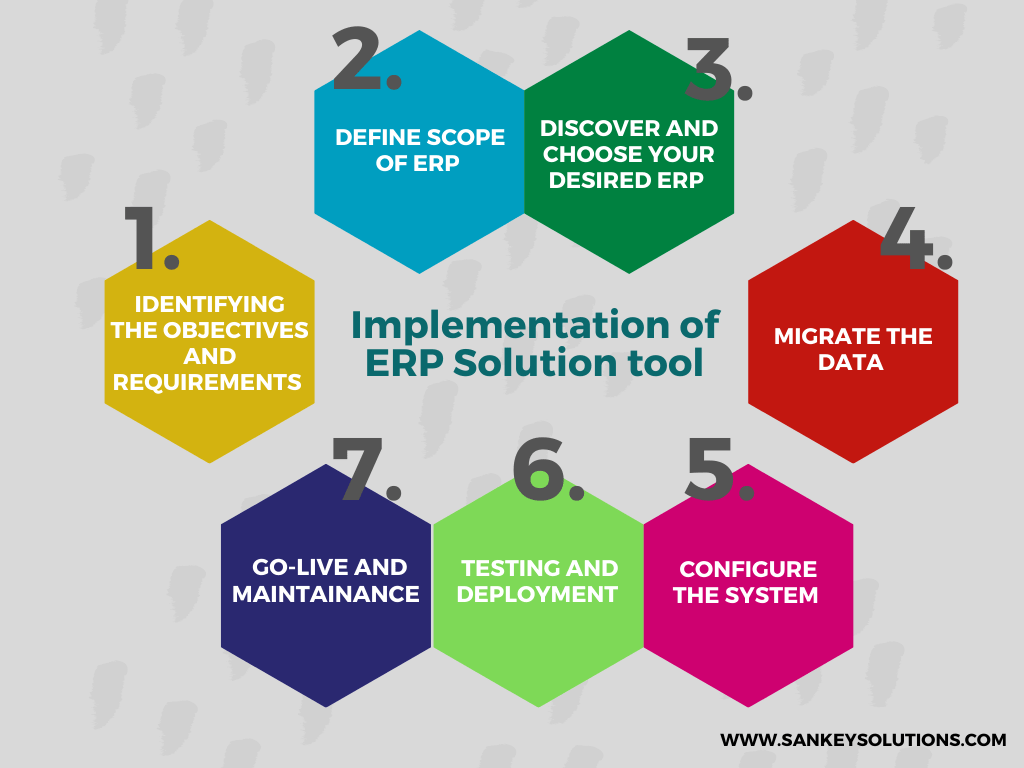A Definitive Guide: How To Implement The ERP Solution Tool Smartly

Amidst agile industry 4.0, businesses are streamlining and synchronizing their management activities by implementing an ERP solution tool. Enterprise Resource Planning, also known as ERP, is a software application that helps to combine different aspects of businesses into one single system using cutting-edge technologies like AI and Machine Learning, etc. ERP solution tool plays an integral part in boosting the growth bars of the businesses thereby maintaining a competitive edge of the company. It plays a significant role in ironing out the jumbled data thereby mapping a systematic representation of data. Implementation of an ERP tool could be effortless but witnessing a successful ERP tool is an arduous process. It turns out to be tedious for most of the organizations to fetch rewards because of implementation failures of the ERP solution tool.
Some common and unavoidable reasons for ERP failure include the change in business goals, substandard execution, poor team planning, lack of organization-wide discussions, and many more. So, how can you make your ERP solution tool implementation rewarding for your organization? How can you ensure your ERP solution tool to be actionable to the organization’s growth and profits?
These 7 essential steps will help you to implement an effective ERP solution tool for your organization:

-
IDENTIFYING THE OBJECTIVES AND REQUIREMENTS
ERP solution tool accompanies boundless solutions for an organization. Hence, it is crucial to identify the objectives and needs of an ERP solution tool in your organization. It should rather focus on the question that states why do we need an ERP solution tool and what we want to achieve in our company? This will shed the light on the business goals of the organization. An effective method could be the analysis of KPI (Key Performance Indicators) that would unearth the changes and modifications an organization needs to adapt to maximize the efficacy. According to a study, nearly 50.7% of organizations have implemented the ERP solution tool for better insights of organization workflow.
Thus, BRAINSTORMING will help you to dig the objectives and goals efficaciously.
-
DEFINE SCOPE OF ERP
Defining the scope of the chosen ERP is perhaps a challenge. This is because what works perfectly for another organization might not necessarily satisfy your business needs. Moreover, it is not necessary that the chosen ERP will address all your needs in one go. Hence, you must consider your industry and business requirements along with anticipating the future expectations and risks of the same.
TIP: Do multiple revisions on budget planning. According to a survey, around 61.1% of ERP implementation delays arise because of budget constraints.
-
DISCOVER AND CHOOSE YOUR DESIRED ERP
We mention discovering the correct ERP as an important step. According to several statistics, around 33% of the organization did not perform strong research on the suitable ERP. Due to this, most of them ended up choosing the ERP that did not play the expected role. Make sure you go through the strategies to choose the best ERP for your organisation for smart implementation process.
We are living in an era where the market is flooded with different competitive ERPs. In the rich pool of different available ERP’s, it turns out to be difficult to figure most suitable ERP for your organization. Thus, an experienced professional team would be an ideal team to understand the compatibility of organization needs and ERP solution tool.
FACT: Various researches unveiled that the Cloud ERP solution or SaaS ERP, is the current preference of customers because of the rich scope in flexibility and adaptation of future requirements.
-
MIGRATE THE DATA
Migration of data follows after the detection of the most suitable ERP according to your organization. This step demands the transfer of the most important and relevant data to process it systematically. The implementation team has to ensure that only required data is migrated in the software to achieve data integrity and efficiency.
FACT: On average, 31% of ERP implementation has undergone a delay in implementation process.
-
CONFIGURE THE SYSTEM
Implementing an ERP solution is a big investment decision by the organization. It requires a large amount of time dedication along with a large pool of resources. It is important to have strategies in place that help you keep a note on your timeline, avoid budget overruns, and go live with meaningful data. Hence, management has to continuously maintain tabs on the ERP software and maintenance schedule.
FACT: TOP 3 benefits of ERP are reduced process time, increase in collaboration, and centralized enterprise-wide data.
-
TESTING AND DEPLOYMENT
Testing and deployment may occur concurrently. It gives you a clear insight into the performance of the system and helps you make a smooth transition. This phase encompasses rigorous testing of full capabilities of the migrated data and includes introductory end-user training. Around 40% of ERP implementations cause major operational disruptions after go-live; therefore, proper implementation is imperative. Testing will help the organization to avoid disruption, downtime, and expense once the system is up and running. Nurturing your ERP implementation after deployment helps to keep users satisfied and ensure the business achieves the desired benefits.
FACT: TOP 3 ERP technologies company are planning to adopt soon are Mobile, SaaS, AND IoT.
-
GO-LIVE AND MAINTAINANCE
Finally, it is time to go live and start coordinating all your activities and resources, effectively streamlining your business operations. Ensure vendor support for answering questions, training reinforcement, webinars, general maintenance, and future system updates and upgrades. Regular maintenance of the ERP solution tool will ensure the performance to be at its peak.
TIP: It is advisable to pursue one additional functionality test, just as a safety precaution.
THE BOTTOM LINE
Implementing an ERP solution into your organization can be worth every penny if implemented correctly. In conjunction with the steps listed above, it is equally important to follow ERP implementation best practices during each phase. Although it takes a substantial amount of time and relentless planning, the invested efforts will pay off in the long term making the transition to the new system rewarding. It is very crucial to enlighten yourself completely before investing in an ERP solution tool.
Sankey Solutions created a Product Data Management (PDM) tool by leveraging ODOO ERP for one of its client. Our process driven methodology of implementing the PDM improved the design workflow of the organization. It unleashed their growth potential by collaborating effectively using 2D & 3D models for explanation purpose. This comprehensive OODO implementation automated the engineering change order and revision control. It also enabled easy access and configuration of files to replace, reuse, and copy the designs. We are glad to know that our client met their business and regulatory requirements thereby optimizing operational resources with maximum visibility. It also reduced the cost and developmental errors along with improving productivity of the entire team.
Click HERE to reach out to our ERP implementation and consultants team having proven implementation methodology and records in the successful implementation. Contact Us Today!